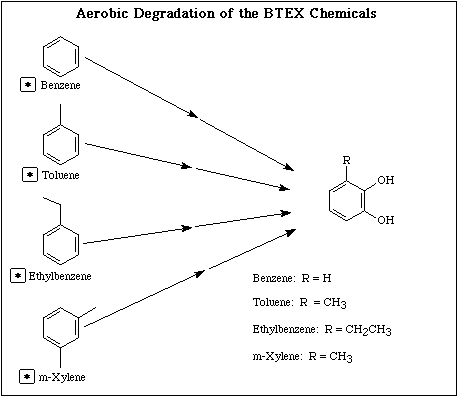
The BTEX chemicals (Benzene, Toluene, Ethylbenzene, and Xylenes) are volatile monoaromatic hydrocarbons which are commonly found together in crude petroleum and petroleum products such as gasoline. They are also produced on the scale of megatons per year as bulk chemicals for industrial use as solvents and starting materials for the manufacture of pesticides, plastics, and synthetic fibers (Harwood et al.,1997). They are considered one of the major causes of environmental pollution because of widespread occurrences of leakage from underground petroleum storage tanks and spills at petroleum production wells, refineries, pipelines, and distribution terminals (Fries et al., 1994). Some estimate that 35% of the 1.4 million gasoline storage tanks in the United States are leaking (Harwood et al., 1997).
Contamination of groundwater with the BTEX compounds is difficult to remedy because these compounds are relatively soluble in water and can diffuse rapidly once introduced into an aquifer. Techniques for in situ bioremediation of the BTEX compounds are used to eliminate or reduce contamination levels in an aquifer.
Bacterial metabolic pathways of BTEX and other aromatic compounds can be divided into two main categories: peripheral pathways and trunk pathways. Peripheral pathways transform a unique compound into a compound common to many metabolic pathways. For example, toluene is anaerobically metabolized to benzoyl-CoA by a system of peripheral pathway enzymes. In turn, benzoyl-CoA is metabolized by trunk pathway enzymes and used as a growth substrate. Many anaerobic aromatic peripheral pathways end in the production of benzoyl-CoA. These pathways are said to "funnel" into the benzoyl-CoA trunk pathway. One of the reasons for the inclusion of metapathway maps in the EAWAG-BBD is their ability to illustrate this funnelling phenomena.
In this metapathway map, m-xylene is used as an example of aerobic and anaerobic degradation of the xylenes. The EAWAG-BBD also includes the aerobic o-xylene pathway and p-xylene pathway.
All of the BTEX compounds have at least one aerobic pathway which includes degradation to a substituted catechol.
Benzene is degraded to catechol.
Toluene has many separate biodegradative pathways, some of which include 3-methylcatechol as an intermediate product.
Many separate pathways also exist for ethylbenzene, which can be degraded to 3-ethylcatechol.
The xylenes are all metabolized to mono-methylated catechols; e.g., m-xylene goes to 3-methylcatechol.
In each of these four cases, the aromatic ring of the substituted catechol is later cleaved by a dioxygenase.
Aerobic Metabolism

|
The asterisk indicates the pathway is currently included in the EAWAG-BBD. Click on it for more information on the pathway or pathways of a particular compound. |

Anaerobic pathways of BTEX biodegradation are important because these compounds are frequently found under conditions where the use of oxygen quickly exceeds the supply.
These conditions are often found in such places as the sediments of all natural bodies of water, groundwater, and sometimes soil (Heider et al., 1997).
Dechloromonas spp. JJ and RCB completely mineralize benzene, through benzoyl-CoA, under anaerobic conditions
(Chakraborty & Coates, 2005).
Benzene, toluene and ethylbenzene have a common biodegradation intermediate: benzoyl-CoA.
This compound is the most common central intermediate of anaerobic aromatic metabolism (Heider et al., 1997).
The aromatic ring of benzoyl-CoA is reduced and eventually transformed to acetyl-CoA.
Few organisms are capable of anaerobically metabolizing xylene. They include strains of denitrifying bacteria capable of using m-xylene as a growth substrate (Harwood et al., 1997).
Dechloromonas RCB can anerobically degrade all three xylene isomers (Chakraborty et al., 2005).
The pathway(s) of anaerobic xylene biodegradation are not well-known.
Anaerobic Metabolism

|
The asterisk indicates the pathway is currently included in the EAWAG-BBD. Click on it for more information on the pathway or pathways of a particular compound. |

Page Author(s): Stephen Stephens
Contact Us© 2025, EAWAG. All rights reserved. http://eawag-bbd.ethz.ch/BTEX/BTEX_map.html